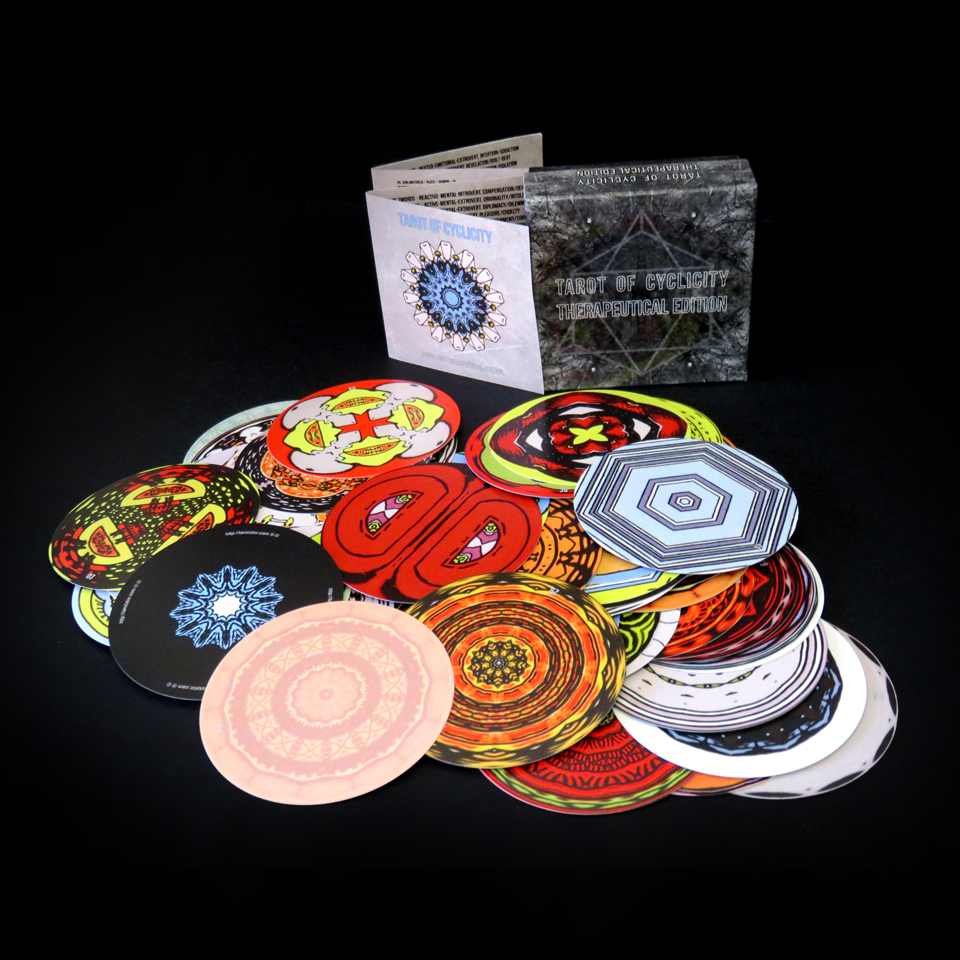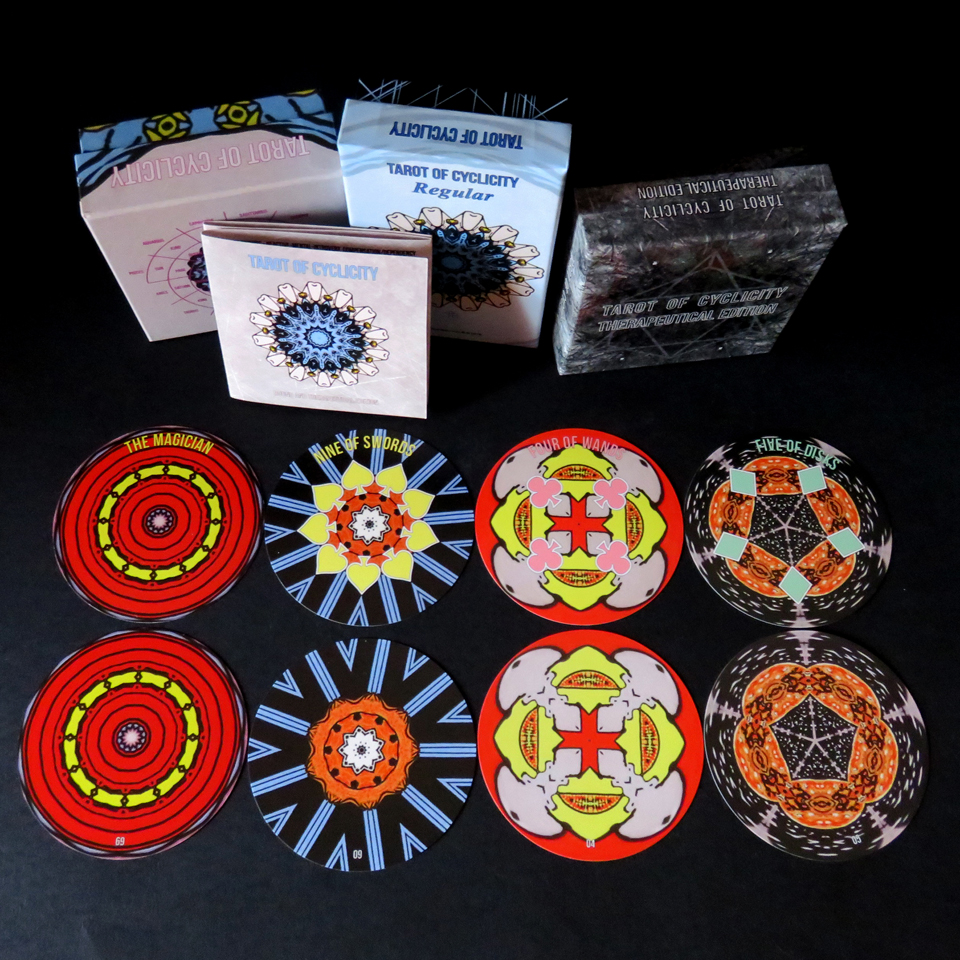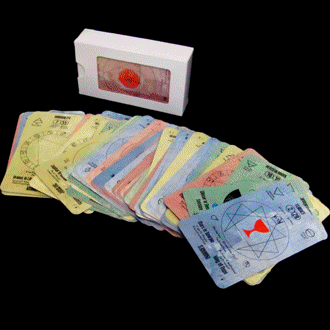
The Tarot deck as a whole and each card separately is a mirror. It is a mirror of the night sky and all the planets and stars, and it is a mirror of ourselves. More someone knows and understands, more will be capable of interpreting from what shows in the mirror.
Instead of looking at the Tarot deck as a holistic symbolical system most of the past scholars focused their efforts on the interpretation of the individual meaning of the Tarot cards.
In the introduction of the “Divinatory Tarot” Papus noted:
“The Tarot is a marvellous whole, and the system that applies to the body must apply to the head and vice versa.”
Papus refers to the connection between the cards of the Major and Minor Arcana, and the importance of study the Tarot deck as a whole.
One hundred years after Papus, Alejandro Jodorowsky speaks about the same approach and connects all the seventy-eight cards of the Tarot deck into one giant Mandala.
The traditional depiction of the cards is explicit and static. The scenes represent situations while the solutions are at the discretion of the interpreter. Everything follows according to predefined scenarios. When someone saw a lying man face down on the ground and stabbed in his back with ten oversised swords, there is none or very little room left for interpretation.
The Waite-Smith’s Ten of Swords is arbitrary, definitive and irreversible. It speaks about the violent end and an inevitable tragic outcome.
However, life is not a series of snapshots, but it is a continuously flowing movie. Life means motion because nothing is static in the universe. Situations are changeable, and humans can make their own choices and determine their own fates. Life is rhythm. Each one of us has the power and the possibility to change the rhythm and as a consequence make their lives better. Someone can choose and can write different scenarios and generate different outcomes. Choose a different path, the one preferred. Although in life the alternatives are not infinite, they are always finite; rarely there are situations with only one possibility at the time.
Instead of depicting arbitrary and definitive situations, the Tarot deck should reflect motion and leave the options open.
“As above, so below”, is the first fundamental esoteric notion to consider: respectively the concept of macrocosm and microcosm. According to Gurdjieff the expressions “macrocosm” means “large cosmos” and “microcosm” means “small cosmos”, respectively “large world” and “small world”. He also stated the teaching of the two cosmoses was passed down from the Kabbalah and other, considerably older systems, though consistent parts of these teachings are now lost, and most remain unknown.
Macrocosm and microcosm refer to a vision of cosmos where the part microcosm reflects the whole macrocosm and vice versa. Esoteric science tended to stress man’s intimate and meaningful relationship with the universe regarding observed and revealed correspondences between the microcosm and macrocosm. Observing and studying one, leads to learning and understanding of the other.
The branches of the esoteric sciences studying the macrocosm are Astronomy and Astrology, while the branches studying the microcosm are Psychology and Alchemy.
The Tarot deck is an instrument built and developed based on Astrology and Numerology and is meant to understand human nature and guide the development of the individual. Therefore, it represents a bridge between the macrocosm and microcosm. The two worlds are mirroring each other and subsequently mirrors the possibilities, the choices, the personality, the fears and the hopes of the beholder.
In the Tarot of Cyclicity, each card is a Mandala of the microcosm and all together are constituting a larger Mandala of the macrocosm.
Each card represents a small mirror in which everyone is allowed to see as much as she or he is prepared to discern and understand. Therefore, the Tarot is not only an advanced instrument for making predictions – educated guesses, but it is also an instrument of self-exploration, self-observation, self-remembering, self-study and therapy. Know yourself, and you will understand others; study others, and you will learn about yourself.
Combining both teachings of Gurdjieff and Jung, the Tarot can be an important part of the healing and developing processes.
Someone can lay out the cards, both, face down or face up and chose a couple of cards or ask another person to draw some cards. Studying these cards may shred a new light upon someone’s current state of mind and soul.
From the seventy-eight cards of the Tarot deck, seventy-two cards are personal, presents situations and dealing with the actions and reaction, respectively the psyche of the individuals. The remaining six cards are impersonal. These six cards represent what is generally considered “external influences”.
The seventy-two cards represent the seventy-two stages of human development, which occultists call “enlightenment”, while Carl Jung calls it “individuation”.
Seventy-two is one of the central numbers of both Eastern and Western mysticism.
In the story of the exodus from Egypt, three consecutive verses describe the manifestations of God’s power. In Hebrew, these three verses each contain seventy-two letters.
The seventy-two Angelic Names or the “seventy-two-fold name” is essential to Sefer Raziel HaMalakh and the Lesser Key of Solomon.
The Sefer Raziel HaMalakh is a grimoire of Practical Kabbalah from the Middle Age; The Lesser Key of Solomon, also known as Clavicula Salomonis Regis or Lemegeton, is an anonymous grimoire compiled in the mid-17th century.
Grimoire is a textbook of magick, also known as a “book of spells”, which typically includes instructions on how to create magical objects such as talismans and amulets, how to perform magical spells, charms and divination, and how to summon or invoke supernatural entities. These supernatural entities are generally called spirits, but also sometimes specifically angels or demons.
Each of these divine names may hold the key to someone’s spiritual development. While the Angels may represent virtues, respectively qualities which someone may develop and practise in order to achieve divinity or perfection; the demons may represent flows and weaknesses that need to be addressed and corrected. Therefore, someone should fully master these seventy-two divine qualities, respectively must overcome the weaknesses, in order to achieve enlightenment.
The novelty of the so-called Therapeutical Edition is that all the texts and extra design elements such as the suite signs were completely removed from the cards. Therefore, the cards can be used similarly as the Rorschach test to examining someone’s personality characteristics and emotional functioning. Each card is numbered from 1 to 78 which facilitate the identification and interpretation of the cards. Having a considerably larger number of cards results in more accurate analyses. The eight-sided, accordion printed mini-booklet features general instructions for interpreting the cards.
Tarot of Cyclicity, round Tarot card deck – 89 USD shipping included.
The round edition consists of 78 Tarot cards, one cover card and five extra cards which features basic Astrology and astrological attributions of the Tarot cards. The cards will be delivered in a custom rigid box.
Superior quality card stock: 330gsm card stock. Smooth and easy to handle.
Round deck dimensions: 89mm x 89mm, 3.5″ x 3.5″.
Also, include the 8-sided, printed mini-booklet.


















